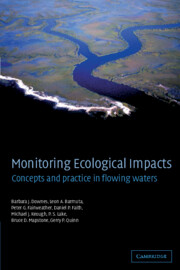Book contents
- Frontmatter
- Contents
- Preface and Acknowledgements
- Part I Introduction to the nature of monitoring problems and to rivers
- Part II Principles of inference and design
- Part III Applying principles of inference and design
- 8 Applying monitoring designs to flowing waters
- 9 Inferential uncertainty and multiple lines of evidence
- 10 Variables that are used for monitoring in flowing waters
- 11 Defining important changes
- 12 Decisions and trade-offs
- 13 Optimization
- 14 The special case of monitoring attempts at restoration
- 15 What's next?
- References
- Index
12 - Decisions and trade-offs
Published online by Cambridge University Press: 21 August 2009
- Frontmatter
- Contents
- Preface and Acknowledgements
- Part I Introduction to the nature of monitoring problems and to rivers
- Part II Principles of inference and design
- Part III Applying principles of inference and design
- 8 Applying monitoring designs to flowing waters
- 9 Inferential uncertainty and multiple lines of evidence
- 10 Variables that are used for monitoring in flowing waters
- 11 Defining important changes
- 12 Decisions and trade-offs
- 13 Optimization
- 14 The special case of monitoring attempts at restoration
- 15 What's next?
- References
- Index
Summary
Statistical decision theory has a long history and can basically be viewed in two ways. Classical statistical hypothesis-testing in the Neyman–Pearson form (Neyman & Pearson 1928), which we described in chapter 4, emphasizes decision errors from the test of a null hypothesis, and these errors have a frequentist interpretation. In contrast, what is termed modern statistical decision theory has a strong Bayesian influence (Berger 1985; Hamburg 1985; Pratt et al. 1996) and has emphasized monetary costs and benefits from decisions in an economic and management context. Nonetheless, all statistical decision problems have certain characteristics in common (Box 12.1; Hamburg 1985; Neter et al. 1993). In this chapter, we will focus on errors associated with the components of the decision-making process and how the choice of criteria for making decisions interacts with the design of the monitoring program.
MAKING STATISTICAL DECISIONS
We need to examine the errors possible from a statistical decision-making process in an environmental monitoring context. In chapter 4 (see Table 4.4) we defined two possible types of error. These errors arise because we are making decisions about the truth or otherwise of hypotheses about unknown population parameters from imperfect samples. If we could record an entire population, such as all the possible locations upstream and downstream of the mine, then we could make decisions about the truth of hypotheses about those parameters without sampling error. Errors of inference may still arise, due to measurement error and confounding.
- Type
- Chapter
- Information
- Monitoring Ecological ImpactsConcepts and Practice in Flowing Waters, pp. 323 - 340Publisher: Cambridge University PressPrint publication year: 2002

